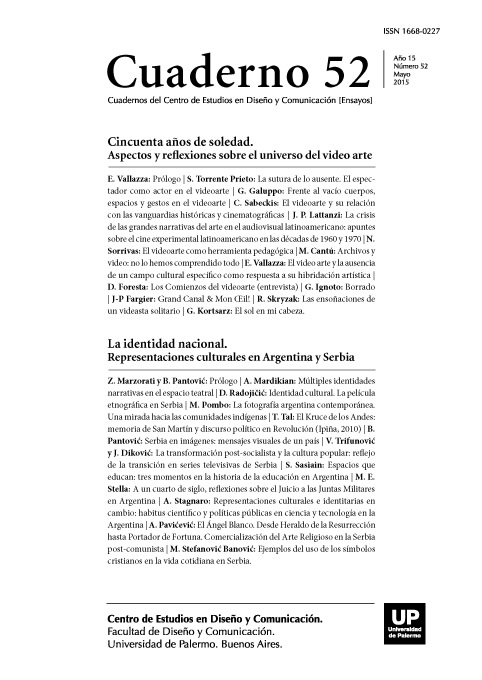Espacios que educan: tres momentos en la historia de la educación en Argentina
Abstract
The aim of this paper is to analyze three moments in the history of public education in Argentina in which there was a change in the ways of understanding the student
and the educational context as a transformational experience.
The national identity is shaped by institutions, and education, from school to university,
has a central place in this construction.
1. Since Argentina declared its independence, and especially when Buenos Aires became
the capital of the new republic in 1880, a vertiginous modernization process began. This
project involved the immigrants who arrived from many different countries to the capital
and transformed it into a Babel that the government had to ‘Argentinize’. Thus the compulsory public education, free and secular was declared in 1884 with the approval of Law 1420.
The new public schools provided the spaces where students could obtain national values.
2. During the first Peronism (1943-1955) technical education had a central role in the modernization project that, in the government’s discourse, is presented as revolutionary: that
of the Nueva Argentina where workers occupied a privileged place. By this period many
typologies were created: from factory-schools to Workers’ University in which, through a
new system of administration, the school space provided services to the community that
exceeded the educational traditional role.
3. Today, the site formerly a winery in one of the most desirable areas in Buenos Aires, has
been recycled to develop an educational project: the scientific and technological center, divided into different sections: the headquarters of the Ministry Science, Technology and Productive Innovation, CONICET and the National Agency for Promotion of Science and Technology and interdisciplinary research institutes, with a large international connection. The new
complex is designed as a management center, production and dissemination of knowledge.
References
Grementeri, F. y Shmidt, C. (2010). Arquitectura, educación y patrimonio. Argentina 1600-
Buenos Aires: Pamplatina.
Longoni, R. et al. (2006). Aulas bonaerenses. un siglo de infraestructura escolar en la Provincia
de Buenos Aires. Publicado en Actas de las III Jornadas de Investigación de la FAU, 2
y 3 de noviembre de 2006.
Pineau, P. (1991). Sindicatos, estado y educación técnica 1936-1968, Buenos Aires: Centro
Editor de América Latina.
[et al.] (2006). El principio del fin. Políticas y memorias de la educación en la última dictadura
militar. (1976-1983). Buenos Aires: Colihue.
Puiggros, A. (dir.) (2006). Historia de la Educación Argentina. Peronismo: Cultura política y
educación (1945-1955) T.V. Buenos Aires: Galerna.
Sarmiento, D. F. (1949). La educación popular. Buenos Aires: Lautaro.
Shmidt, C. (2012). Palacios sin reyes. Arquitectura pública para la “capital permanente”. Buenos
Aires, 1880-1890. Rosario: Prohistoria.
Snow, C. P. (1987). Las dos culturas y un segundo enfoque. Madrid: Alianza.
Tedesco, J. C. (2003). Educación y sociedad en la Argentina (1880-1945). Buenos Aires: S. XXI.
(1996). Nueva Sociedad Nro. 146 Noviembre-Diciembre 1996, pp. 74-89. Disponible en
www.nuso.org. Consultado el 25/5/12.
Torrado, S. (compiladora). (2006). Población y bienestar en la Argentina del primero al segundo
Centenario. Una historia social del siglo XX. Tomo II. Buenos Aires: Edhasa.
Polo Científico Tecnológico. Disponible en www.polo.mincyt.gob.ar/ Consultado el 10/3/12.
Los autores/as que publiquen en esta revista ceden los derechos de autor y de publicación a "Cuadernos del Centro de Estudios de Diseño y Comunicación", Aceptando el registro de su trabajo bajo una licencia de atribución de Creative Commons, que permite a terceros utilizar lo publicado siempre que de el crédito pertinente a los autores y a esta revista.


